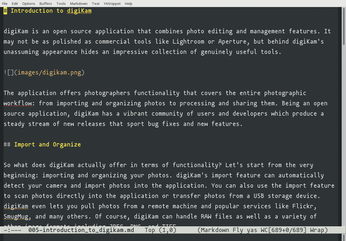Emacs for writers
Emacs can be anything you want it to be: a coding environment, an outliner, a task manager, and everything in between. You can transform this versatile text editor into a tool for writing articles, drafting blog posts, and penning your next great novel (Figure 1). As is often the case, the exact Emacs configuration and customizations depend on your specific needs and usage scenarios, but there are several tweaks and plugins you might find useful no matter what writing tasks you plan.
Configuring and Extending Emacs
The .emacs file in your home directory specifies Emacs' default behavior and configures a wide range of settings. The example configuration in Listing 1 contains several useful commands and options. The default monospaced font and line spacing make regular text difficult to read, and the set-default-font and setq-default line-spacing expressions let you specify the desired font (it must be installed on your system), font size, and line spacing. In this case, Emacs is set to use the Mononoki font at the 17pt size.
[...]
Buy this article as PDF
(incl. VAT)
Buy Linux Magazine
Subscribe to our Linux Newsletters
Find Linux and Open Source Jobs
Subscribe to our ADMIN Newsletters
Support Our Work
Linux Magazine content is made possible with support from readers like you. Please consider contributing when you’ve found an article to be beneficial.

News
-
Fedora 43 Has Finally Landed
The Fedora Linux developers have announced their latest release, Fedora 43.
-
KDE Unleashes Plasma 6.5
The Plasma 6.5 desktop environment is now available with new features, improvements, and the usual bug fixes.
-
Xubuntu Site Possibly Hacked
It appears that the Xubuntu site was hacked and briefly served up a malicious ZIP file from its download page.
-
LMDE 7 Now Available
Linux Mint Debian Edition, version 7, has been officially released and is based on upstream Debian.
-
Linux Kernel 6.16 Reaches EOL
Linux kernel 6.16 has reached its end of life, which means you'll need to upgrade to the next stable release, Linux kernel 6.17.
-
Amazon Ditches Android for a Linux-Based OS
Amazon has migrated from Android to the Linux-based Vega OS for its Fire TV.
-
Cairo Dock 3.6 Now Available for More Compositors
If you're a fan of third-party desktop docks, then the latest release of Cairo Dock with Wayland support is for you.
-
System76 Unleashes Pop!_OS 24.04 Beta
System76's first beta of Pop!_OS 24.04 is an impressive feat.
-
Linux Kernel 6.17 is Available
Linus Torvalds has announced that the latest kernel has been released with plenty of core improvements and even more hardware support.
-
Kali Linux 2025.3 Released with New Hacking Tools
If you're a Kali Linux fan, you'll be glad to know that the third release of this famous pen-testing distribution is now available with updates for key components.


